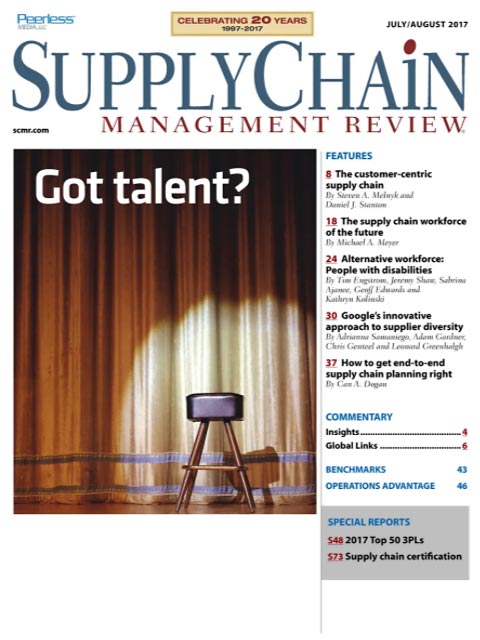Sorry, but your login has failed. Please recheck your login information and resubmit. If your subscription has expired, renew here.
July-August 2017
A few years ago, a Harvard Business Review cover posed the question: What’s the secret to winning in the global economy? The answer: Talent. Browse this issue archive.Need Help? Contact customer service 847-559-7581 More options
Leading industry analysts maintain that the “mega-deals” witnessed over the past two years in the third-party logistics provider (3PL) sector have abated, but that certainly doesn’t mean that mergers and acquisitions (M&A) will fall out of the picture.
According to Evan Armstrong, president of the consultancy Armstrong & Associates, the 3PL market is also still ripe for equity investment. “The one outstanding example of this was when Aerospace, Transportation and Logistics [ATL Partners] bought a controlling share of Pilot Freight Services late last year,” he says. “We also anticipate more M&A activity as 3PLs strive to expand geographic scale and provide integrated solution offerings.”
At the same time, says Armstrong, technological changes are having a dramatic impact on 3PL operations. Companies such as project44, MacroPoint and others are driving improved transit status data and carrier capacity information from transportation providers to lead logistics companies.
“This year’s electric logging devices [ELD] mandate could also be a boon for shipment tracking and carrier capacity monitoring information,” says Armstrong. “These types of advances allow for more process automation and increased operational efficiencies. They’re also increasing the quality of information available to customers of non-asset based transportation managers.”
Specifically, industries such as pharmaceuticals are increasing their digitalization needs, Armstrong’s research reveals, putting more emphasis on 3PLs to match these new technological demands. To better ensure counterfeit products are not being sold within established sales channels, for example, the pharmaceuticals industry has a 2017 mandate to begin capturing product serial numbers across its supply chains.

This complete article is available to subscribers only.
Log in now for full access or start your PLUS+ subscription for instant access.
SC
MR
Sorry, but your login has failed. Please recheck your login information and resubmit. If your subscription has expired, renew here.
July-August 2017
A few years ago, a Harvard Business Review cover posed the question: What’s the secret to winning in the global economy? The answer: Talent. Browse this issue archive. Access your online digital edition. Download a PDF file of the July-August 2017 issue.Leading industry analysts maintain that the “mega-deals” witnessed over the past two years in the third-party logistics provider (3PL) sector have abated, but that certainly doesn’t mean that mergers and acquisitions (M&A) will fall out of the picture.
According to Evan Armstrong, president of the consultancy Armstrong & Associates, the 3PL market is also still ripe for equity investment. “The one outstanding example of this was when Aerospace, Transportation and Logistics [ATL Partners] bought a controlling share of Pilot Freight Services late last year,” he says. “We also anticipate more M&A activity as 3PLs strive to expand geographic scale and provide integrated solution offerings.”
At the same time, says Armstrong, technological changes are having a dramatic impact on 3PL operations. Companies such as project44, MacroPoint and others are driving improved transit status data and carrier capacity information from transportation providers to lead logistics companies.
“This year’s electric logging devices [ELD] mandate could also be a boon for shipment tracking and carrier capacity monitoring information,” says Armstrong. “These types of advances allow for more process automation and increased operational efficiencies. They’re also increasing the quality of information available to customers of non-asset based transportation managers.”
Specifically, industries such as pharmaceuticals are increasing their digitalization needs, Armstrong’s research reveals, putting more emphasis on 3PLs to match these new technological demands. To better ensure counterfeit products are not being sold within established sales channels, for example, the pharmaceuticals industry has a 2017 mandate to begin capturing product serial numbers across its supply chains.
 SUBSCRIBERS: Click here to download PDF of the full article.
SUBSCRIBERS: Click here to download PDF of the full article.
SC
MR


More 3PL
- 2024 Warehouse/DC Operations Survey: Technology adoption on the rise
- Looking back at NextGen 2024
- Manufacturing again contracts in October, reports ISM
- Parcel shipping spend: The untamed holdout in today’s supply chains
- NextGen Supply Chain Conference set for October 21-23
- Penske, NTT Data, CSCMP study finds change still dominates 3PL market
- More 3PL
Latest Podcast

 Explore
Explore
Business Management News
- 2024 Warehouse/DC Operations Survey: Technology adoption on the rise
- Benchmarking the complexity of ESG reporting
- Looking back at NextGen 2024
- The Corporate Sustainability Due Diligence Directive
- How to make your CFO a supply chain superfan
- Manufacturing again contracts in October, reports ISM
- More Business Management
Latest Business Management Resources

Subscribe

Supply Chain Management Review delivers the best industry content.

Editors’ Picks






